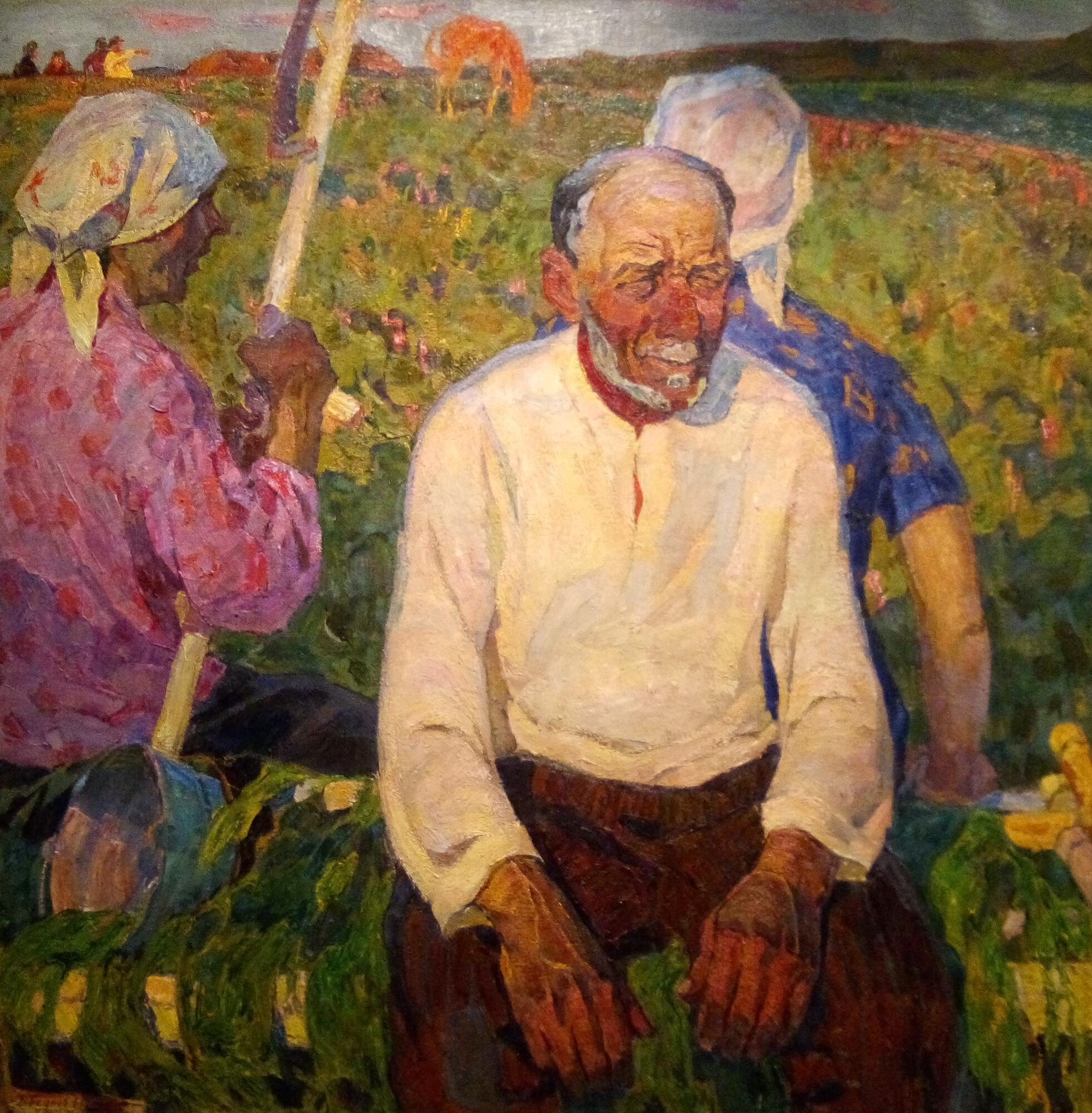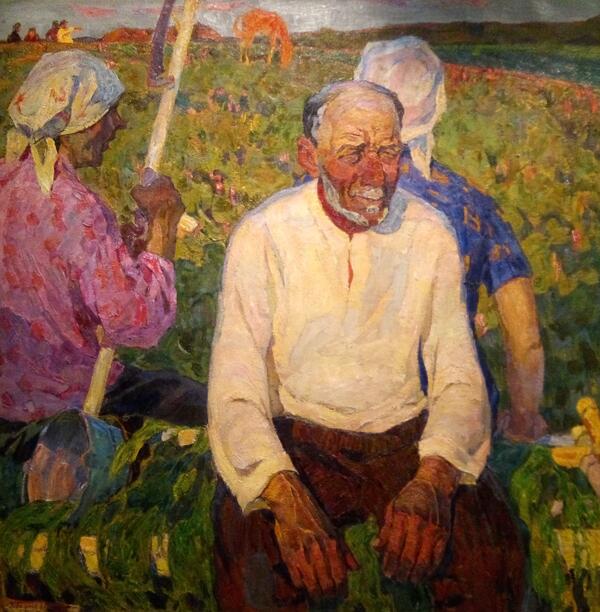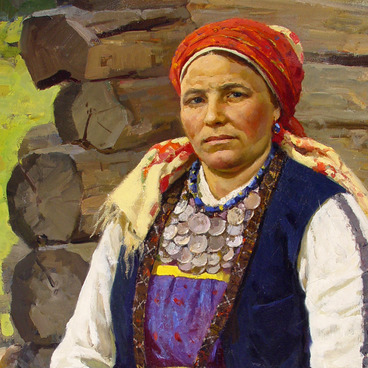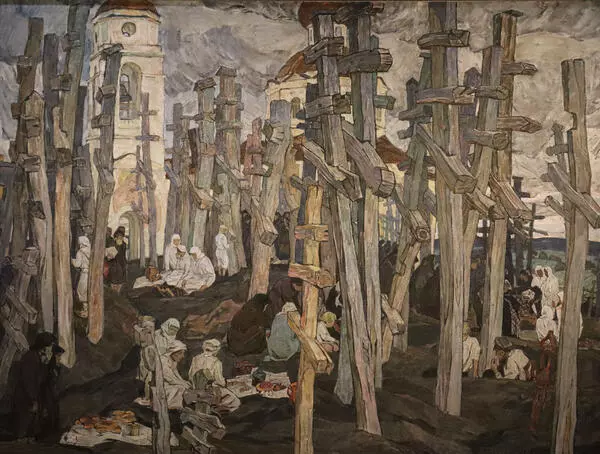In the 1960s, Mordovian artists actively elaborated on the theme of land and labor in large-scale compositions. Viktor Bednov, an Honored Artist of the Russian Federation, also dedicated a number of his works to this topic.
His interest in the theme of land and labor arose not only due to the artistic trends of that time, but also due to the artist’s personal feelings. Viktor Bednov was born in a rural area and grew up among the picturesque expanses of the village of Kochelayevo, Kovylkinsky district. The rural way of life, and the hardships and holidays of fellow countrymen were well known to the artist from early childhood.
Viktor Bednov traveled a lot in the region. The painting “Hay-Makers from Shoksha” was inspired by a trip to the Tengushevsky district of the Republic of Mordovia. As the main narrative motif, the artist chose the unity of nature and people, who work on their native land.
The choice of the protagonist is not accidental: the image of the worker is an embodiment of the power and wisdom of the people. The prototype for the figure of the old man depicted in the foreground in the center of the composition was a real person. Viktor Bednov met an old man Foma during the trip. He was a simple peasant, illiterate, but a skillful worker.
Unlike the two women depicted from the back, the elderly hay-maker faces the viewer. In front of us is a tanned peasant in a white shirt without a collar, with his knobby hands on his knees. A wrinkled face testifies to the hardships he has experienced. But the past difficulties have not deprived the peasant of a stubborn love of life and a desire to work on his native land.
The extended background creates a feeling of a leisurely flow of everyday life: we see the workday coming to an end, the setting sun illuminating the distant forest, the figures of peasants, and a grazing horse. The play of light and shadows make canvas more dynamic, and allows us to accurately determine the time of the painting.
Leaving a high horizon line, Viktor Bednov seems to be bringing us closer to the heroes, to nature and to rural mundane life. This feeling is emphasized by the natural colors of the heroes’ clothes, and the earthy complexion of the old man’s face. The artist admires the wise and measured peasant life, and tries to capture the peculiarities of the culture of the Mordovian village.
His interest in the theme of land and labor arose not only due to the artistic trends of that time, but also due to the artist’s personal feelings. Viktor Bednov was born in a rural area and grew up among the picturesque expanses of the village of Kochelayevo, Kovylkinsky district. The rural way of life, and the hardships and holidays of fellow countrymen were well known to the artist from early childhood.
Viktor Bednov traveled a lot in the region. The painting “Hay-Makers from Shoksha” was inspired by a trip to the Tengushevsky district of the Republic of Mordovia. As the main narrative motif, the artist chose the unity of nature and people, who work on their native land.
The choice of the protagonist is not accidental: the image of the worker is an embodiment of the power and wisdom of the people. The prototype for the figure of the old man depicted in the foreground in the center of the composition was a real person. Viktor Bednov met an old man Foma during the trip. He was a simple peasant, illiterate, but a skillful worker.
Unlike the two women depicted from the back, the elderly hay-maker faces the viewer. In front of us is a tanned peasant in a white shirt without a collar, with his knobby hands on his knees. A wrinkled face testifies to the hardships he has experienced. But the past difficulties have not deprived the peasant of a stubborn love of life and a desire to work on his native land.
The extended background creates a feeling of a leisurely flow of everyday life: we see the workday coming to an end, the setting sun illuminating the distant forest, the figures of peasants, and a grazing horse. The play of light and shadows make canvas more dynamic, and allows us to accurately determine the time of the painting.
Leaving a high horizon line, Viktor Bednov seems to be bringing us closer to the heroes, to nature and to rural mundane life. This feeling is emphasized by the natural colors of the heroes’ clothes, and the earthy complexion of the old man’s face. The artist admires the wise and measured peasant life, and tries to capture the peculiarities of the culture of the Mordovian village.






